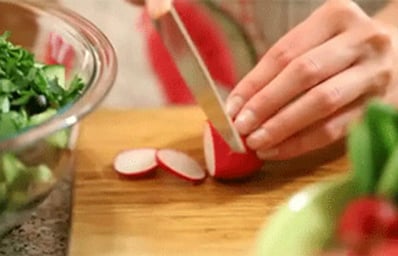I’m fed up with people hating on salad. You can’t hate on something that you don’t even know how to make properly. I eat a lot of salad, and I don’t mean to brag, but I like to consider myself a master of the homemade salad. Seeing people blindly put ranch dressing on romaine lettuce hurts–it’s gross to watch and I’m sure gross to eat. If you’re one of those people, try something new and (please) learn to move past that basic salad. Here are three mistakes that you’re probably making when making a salad and how to fix them.
1. You’re Using One Type of Lettuc
I’m telling you now, a huge reason you claim that you don’t like salad is because you don’t know how to start one. It’s all about the foundation. You might not like kale or spinach, but you probably haven’t treated it right. Plus, it’s good for you. Not only do they have unparalleled health benefits (check out this article about kale and this article about spinach) but they add variety to your salad. You benefit your body while eating something that’s actually pretty delicious. Hear me out, if you add a little bit of romaine and cabbage, then some thinly cut kale and spinach, you’ve already got the foundation of a great salad. You won’t be able to taste the bitterness if you pair it with a good salad dressing, but I’ll get into that later.
2. Not Adding Topping
This is the biggest mistake a salad constructor can make. Toppings are key to making your salad taste good. Start out with something basic such as red peppers, green onions or cucumbers, and make sure they’re cut into small cubes. The watery vegetables are going to mix well with the crispy lettuce and add a nice crunch.
Secondly, add something with a little more flavor. I usually opt for black olives, but you could add beets, mushrooms or corn. Then, if you’re feeling adventurous, add some jalapeños.
Next, add some protein. Beans are a good option for this if you’re vegetarian or vegan. I like to add garbanzo beans, white beans, kidney beans or even edamame. Protein is very important; it’s good for muscular health, immune defense, energy, skin health and more.
Lastly, add some nuts for a filling fat source. Roasted almonds are my favorite, but walnuts, sesame seeds or even sunflower seeds (without the shells) are great too.
Croutons are a great addition as well, but if you’re aiming to be healthier, they may not be the best option since they’re just bread squares. Remember – sometimes less is more with toppings in salad. If you’re trying to eat salads for health, check out this article that talks about the worst salad toppings and some healthy replacements.
3. Dressing
Okay, you may be thinking “Sierra, there’s no way I can mess up the salad dressing, it’s the best part”, but listen, you totally can mess it up. You can befoul the sh*t out of it.
First of all, if your aim is to be healthier, you need to watch out. Salads are healthy and low in calories, but the dressing is where the calories can sneak up on you. Be aware of what the serving size is and what’s in your dressing; it could prevent you from reaching your goal.
On the other hand, you have to be careful of the amount for different reasons. Too much salad dressing can make your salad gross and soggy, and too little can make it bland and boring. Find a happy medium.
#SpoonTip: Remember that you can always add more, but you can’t take away.
Lastly, you want a dressing that complements your toppings. This is something that you’ll figure out as you make more salads and figure out what you like. Don’t be scared to try a new dressing or topping–you might end up discovering something truly yummy.
As you can see, salads can actually be really delicious and good for you. Hopefully these tips help decrease the amount of salad bashing in the world. I encourage everyone to try making a full, colorful salad at least once. And if you find that you’d rather eat lettuce and ranch, I can respect that. But once you’re educated in the art of salad creation, you’ll never stop loving them, trust me.


